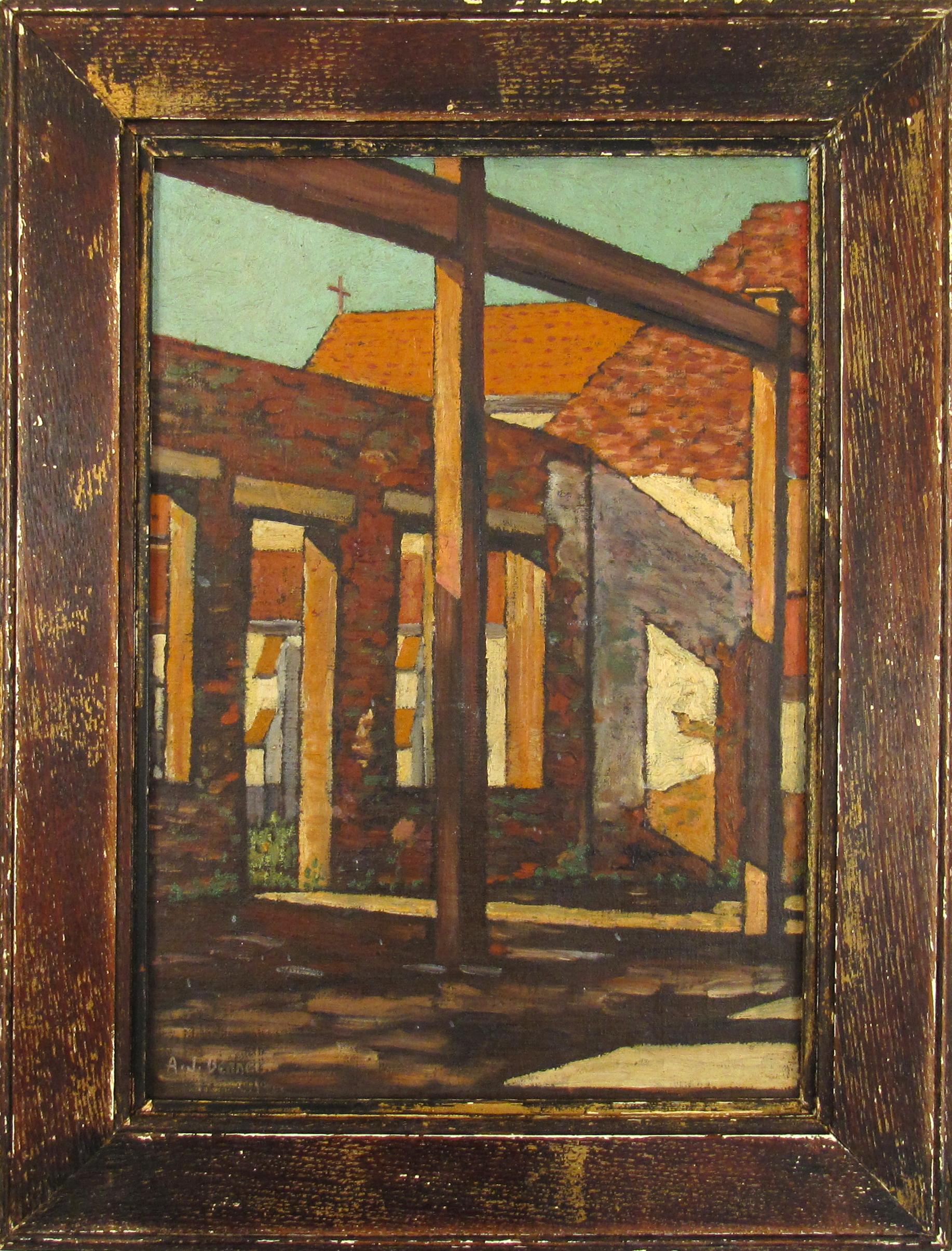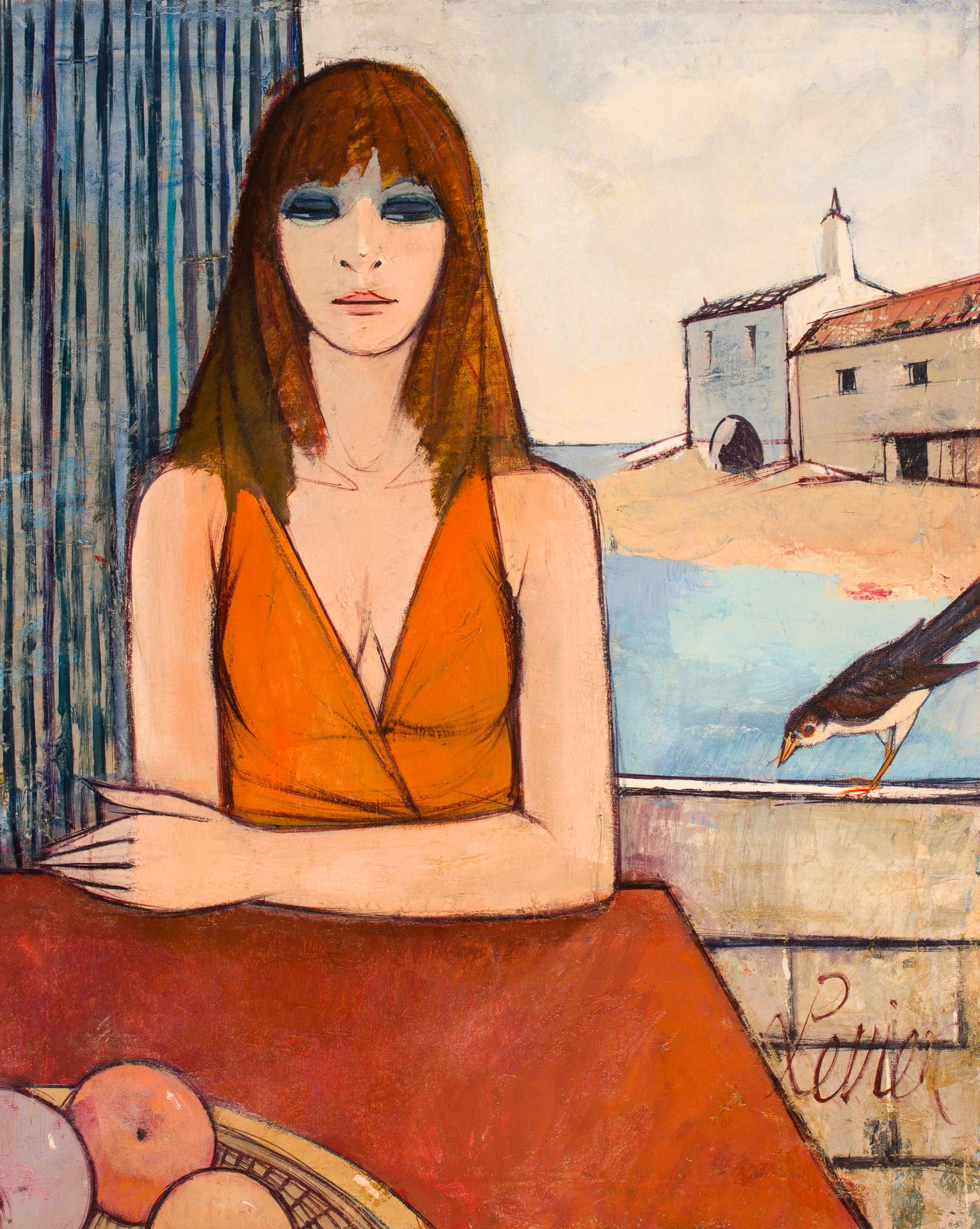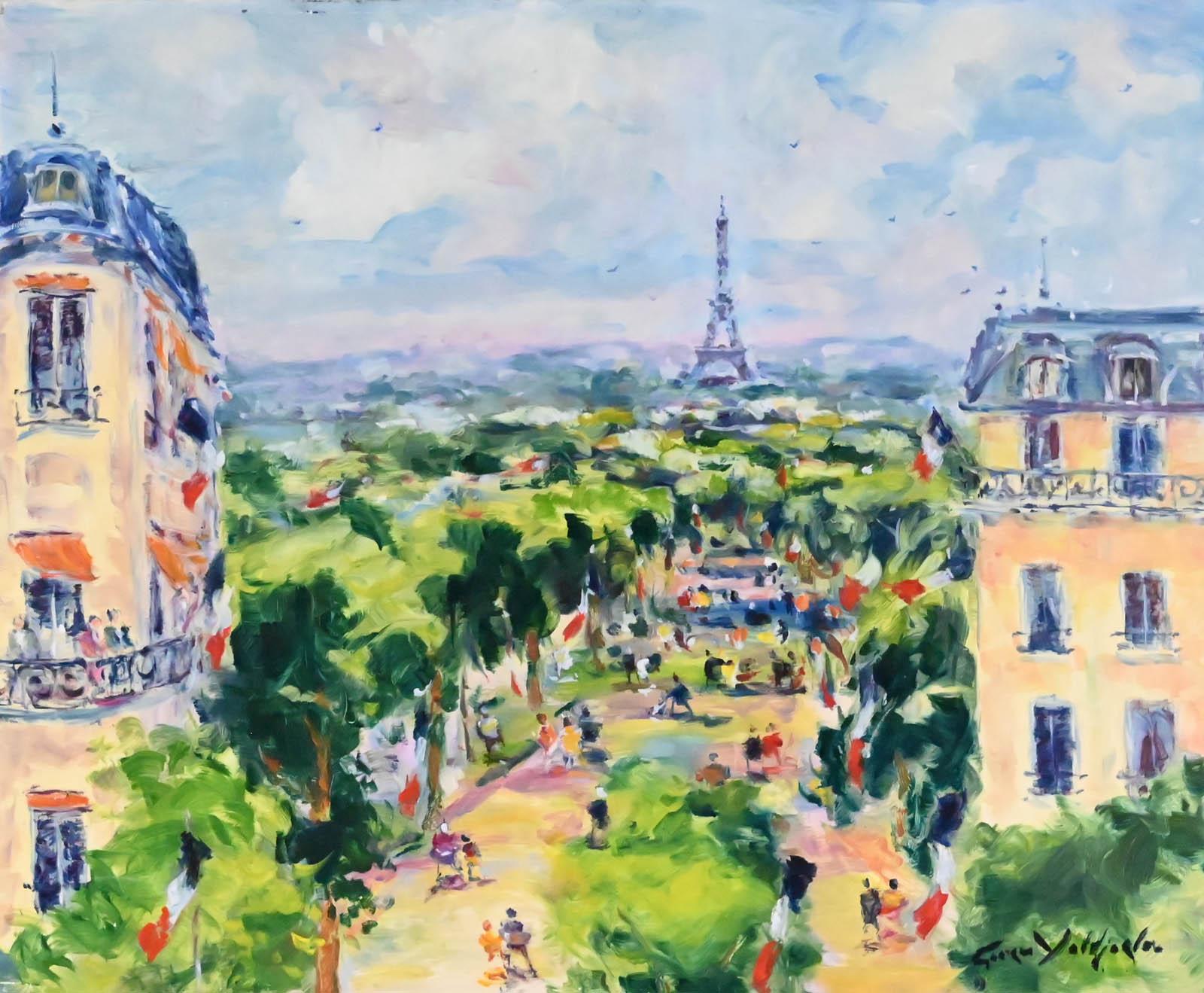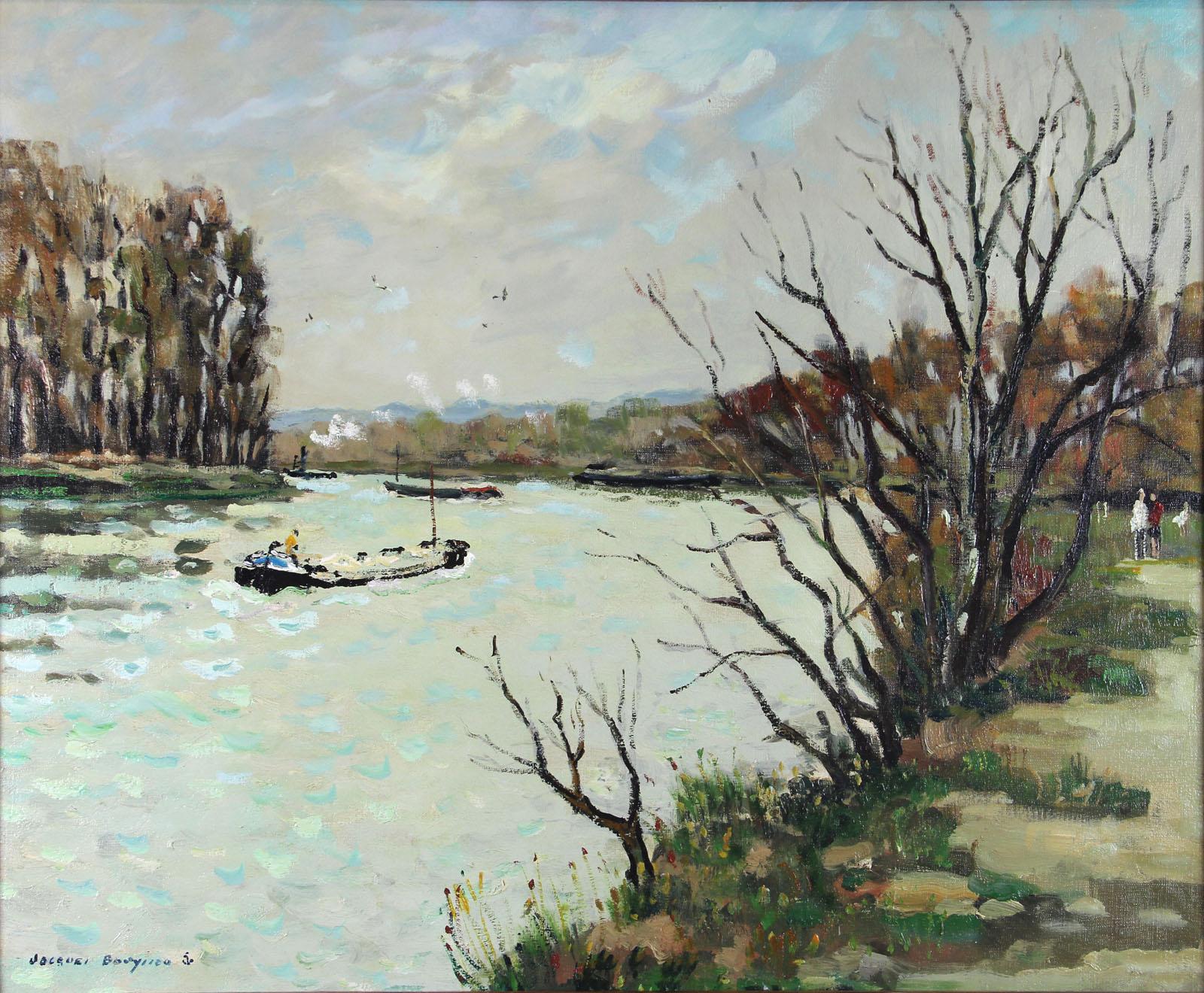Items Similar to "Theatre de Sara Barnhardt", Edouard Cortes, 13x18, Oil on Canvas, Impressionism
Video Loading
Want more images or videos?
Request additional images or videos from the seller
1 of 22
Édouard Cortès"Theatre de Sara Barnhardt", Edouard Cortes, 13x18, Oil on Canvas, Impressionism1935-40
1935-40
About the Item
Theatre de Sara Bernhart et Place de Chatelet by Edouard Cortes was painted circa 1935-40 and signed lower right. It is an oil on canvas measuring 13x18. The piece is included in the Catalogue Raisonne - The complete works of Cortes and includes the certificate of authenticity to prove it. The piece is also finished in a beautiful gold ornate frame. The Theatre de la Ville Paris was once known as the Theatre Sarah Bernhardt and is one of two theatres in Paris built in the 1860s that are located opposite each other at the Place du Chatelet and this venue has a varied program throughout the year of theatre music and dance.
Edouard Cortes was born in Lagny, France on April 26, 1882, a time when Paris was considered the center of the art world. Artist from across the globe traveled there to study with the 'masters' and paint France's beautiful countryside and cities and views of Paris, or as it became known ‘the City of Lights’, were in great demand by both collectors and tourists. Edouard Cortès, along with other artists like: Eugene Galien-Laloue (1854-1941), Luigi Loir (1845-1916) and Jean Beraud (1849-1936) answered their call. Specializing in Paris street scenes, each of these artists captured the city during its heyday and continued with these scenes well into the 20th century.
In 1899, at the age of 16, he exhibited his first work at the Société des Artistes Français entitled La Labour. The work was well received by the critics and the public - helping establish Édouard’s favorable reputation in Paris. It was at the turn of the century, c.1900, that he began to paint the scenes that he would become most famous for – Paris’ streets and monuments. One of the more prolific artists of his time, Cortès found his niche and stayed with it. His views of Paris are among the most telling and beautiful images of this genre; capturing the city during all its seasons for more than 60 years. Edouard married Fernande Joyeuse in 1914 and had a child – Jacqueline Simone in 1916. Fernande died in 1918 and shortly after that Edouard decided to marry his sister-in-law Lucienne Joyeuse. They settled in Paris and Edouard continued to paint views of Paris. By the mid 1920’s, Edouard and his family moved back to Lagny (in Normandy) and he began painting
scenes of country life - including landscapes, interior scenes and still lives. He was an active member of the Union des Beaux-Arts de Lagny and was the Unions first president. Their inaugural exhibition was held in 1927 and Cortès continued to exhibit there until the late 1930’s.
During this period he received many awards, gained great notoriety and was a frequent exhibitor at the exhibition halls in Paris, including the Salon d’Automne, Salon d’Hiver, Salon de la Société Nationale de l’Horticulture and Salon des Indépendants.
His qualities as a painter, in addition to his sensitivity, allowed him to paint the street scenes of that time under their most charming, attractive and real light. Transposed by his brushes, each spot of Paris becomes a veritable sparkling jewel. The most ordinary scene, through a sensitive, generous and elaborate palette, irresistibly fascinates and moves us. Only through a detailed study of his canvases can we understand how this artist, with apparently simple means, could obtain
such gripping effects. His bold touch never lingers over a superfluous detail. What best proves his talent is the accuracy of his drawing and the naturalness of the scene he paints, his extraordinary use of sun or rain, with reflections in the puddles in the streets.
It was therefore natural for such a talent to be recognized in France and throughout the world as that of a first class artist with great sensitivity and high artistic qualities. It is not surprising that his works, more valuable each day, were appreciated by many collectors.
Cortès’ beautiful depictions of Paris were always in demand and he continued to paint them until his death in 1969.
- Creator:Édouard Cortès (1882 - 1969)
- Creation Year:1935-40
- Dimensions:Height: 13 in (33.02 cm)Width: 18 in (45.72 cm)Depth: 3 in (7.62 cm)
- More Editions & Sizes:27x33 in. framedPrice: $42,500
- Medium:
- Movement & Style:
- Period:
- Condition:
- Gallery Location:Dallas, TX
- Reference Number:1stDibs: LU1301210919622
About the Seller
5.0
Gold Seller
These expertly vetted sellers are highly rated and consistently exceed customer expectations.
Established in 1967
1stDibs seller since 2019
22 sales on 1stDibs
Typical response time: 1 hour
- ShippingRetrieving quote...Ships From: Dallas, TX
- Return PolicyA return for this item may be initiated within 14 days of delivery.
More From This SellerView All
- "Le Pantheon - Paris, 1905", Edouard Cortes, 13x18, Oil on Canvas, ImpressionismLocated in Dallas, TXVaudeville Theatre by Edouard Cortes was painted circa 1955-60 and signed lower left. It is oil on canvas measuring 13x18 in original unlined condition. The piece is included in the ...Category
1950s Post-Impressionist Landscape Paintings
MaterialsCanvas, Oil
- "Theatre du Vaudeville", Edouard Cortes, 18x22, Oil/Canvas, French ImpressionismLocated in Dallas, TXVaudeville Theatre by Edouard Cortes was painted circa 1955-60 and signed lower left. It is oil on canvas measuring 18x22 in original unlined condition....Category
1950s Post-Impressionist Landscape Paintings
MaterialsCanvas, Oil
- "Danse Enchanteresse", Gerard Valtier, Oil on Canvas, French, 35x46 in., MusicBy Gerard ValtierLocated in Dallas, TX"Danse Enchanteresse" by Gerard Valtier is an original oil on canvas that measures 35x46 inches. Impressionistic painting uses an array of bright colors to create a fun, musical imag...Category
2010s Impressionist Figurative Paintings
MaterialsCanvas, Oil
- "Les Lumieres de la Boulevard", Gerard Valtier, Oil on Canvas, French, 28x23 in.By Gerard ValtierLocated in Dallas, TX"Les Lumiere de la Boulevard" by Gerard Valtier is an original oil on canvas that measures 28x23 inches. This impressionistic painting has an array of bright colors to create a fun a...Category
2010s Impressionist Figurative Paintings
MaterialsCanvas, Oil
- "Le Cafe Boheme de Paris", Gerard Valtier, Oil on Canvas, French, 29x36 in.By Gerard ValtierLocated in Dallas, TX"Le Cafe Boheme De Paris" by Gerard Valtier is an original oil on canvas that measures 29x36 inches. This impressionistic painting has an array of bright c...Category
2010s Impressionist Figurative Paintings
MaterialsCanvas, Oil
- "Folle Soiree Musicale", Gerard Valtier, Oil on Canvas, French, 47x47 in., DanceBy Gerard ValtierLocated in Dallas, TX"Folle Soiree Musicale" by Gerard Valtier is an original oil on canvas that measures 47x47 inches. The impressionistic painting uses an array of bright colors to create a fun, musica...Category
2010s Impressionist Figurative Paintings
MaterialsCanvas, Oil
You May Also Like
- A. J. Bennett - Light and Shade - Post Impressionist Painting, South Africa 1919Located in Meinisberg, CHA. J. Bennett (South African, fl. Early 20th century) Light and Shade • Oil on canvas artist board ca. 42.5 x 29.5 cm • Later frame ca. 53.5 x 41 cm Worldwide shipping is complime...Category
1910s Post-Impressionist Figurative Paintings
MaterialsCanvas, Oil, Board
- PrintempsBy Charles LevierLocated in Costa Mesa, CAA beautiful woman sits at an open window, gazing down at a small bird who has landed nearby in this serene portrait by Charles Levier. Warm orange tones are played off their complements in shades of blue, the artist utilizing several different layers of oils to create a subtle and relaxed view of a spring day near the sea. Beyond the window a small chapel sits on a peninsula, surrounded tranquil blue waters. This work, like many of Levier's, belongs to the French figurative movement of the Glorious Thirty (Les Trente Glorieuses) - the golden period of thirty years after WWII which were a time of great hope and prosperity in France. Inspired by Hollywood cinema, Charles Levier sought harmony in composition and purity of color and form. His said that his creations represented "a light and delicate world, of dark and subtle shades and colors." Levier worked in a somewhat abstracted, cubist style. Additionally he often employed the French technique of "cloisonnism" (after the French for "partition"), a style of post-Impressionist painting with bold and flat forms separated by dark contours, also seen in this work. The term was coined by critic Edouard Dujardin on the occasion of the Salon des Indépendants, in March 1888 and was commonly used by artists like Émile Bernard, Louis Anquetin, Paul...Category
Mid-20th Century Post-Impressionist Figurative Paintings
MaterialsCanvas, Oil
- Haystack with Resting FiguresBy John Maclauchlan MilneLocated in Hillsborough, NCScottish artist John Maclauchlan Milne, RSA, (1885-1957) is a contemporary of Scottish Colourists Peploe, Fergusson, Cadell and Hunter. Like the...Category
1920s Post-Impressionist Landscape Paintings
MaterialsCanvas, Oil
- Vue de RouenBy Gaston SebireLocated in LE HAVRE, FRGaston Sebire (1920-2001) Vue de Rouen Oil on canvas Size : 65 x 81 cm Signed lower right Provenance : Private Collection, France Very good condition. Original canvas. Frame included...Category
1960s Post-Impressionist Landscape Paintings
MaterialsCanvas, Oil
- Paris, vue sur les jardins de la Tour EiffelLocated in LE HAVRE, FRGeorges YOLDJOGLOU ( né en 1933) Paris, vue sur les jardins de la Tour Eiffel Oil on canvas Size : 60 x 73cm Signed lower right Titled on the back...Category
21st Century and Contemporary Post-Impressionist Figurative Paintings
MaterialsCanvas, Oil
- Carrière sur SeineBy Jacques BouyssouLocated in LE HAVRE, FRJacques BOUYSSOU (1926-1997) Carrière sur Seine, 1966 Oil on original canvas, in perfect condition, original canvas. Size : 50 x 65 Signed lower left Vintage frame Provenance : - G...Category
1960s Post-Impressionist Landscape Paintings
MaterialsCanvas, Oil
Recently Viewed
View AllMore Ways To Browse
French Impressionism Art
French Impressionism French Impressionism Art
French Impressionism Painting
French Impressionism Oil Paintings
French Impressionism Oil Painting
Impressionism Paris
French Art Theatre
20th Century Impressionism
Theatre Canvas
20th Century Impressionism Paintings
Oil Paintings Theatre
French Impressionism Landscapes
Post Impressionism Painting
Oil Impressionism Paris
Vintage Theatre Sign
Vintage Theatre Signs
Ville De French
Theatre Light Used





